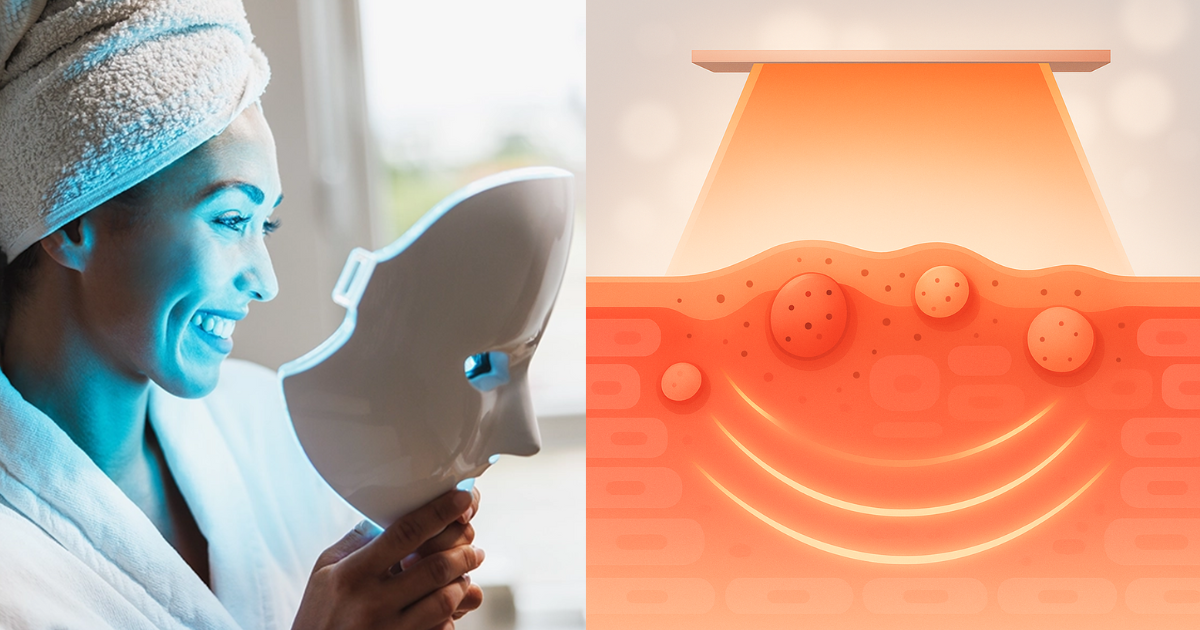Best LED Face Mask for Acne: Blue and Red Light Options for Home Use
Persistent breakouts despite a solid skincare routine can be discouraging. If you’ve run through retinoids, benzoyl peroxide, and even prescriptions, an at-home LED face mask offers a gentle, non-invasive approach using blue and red light wavelengths to target acne-causing bacteria and calm inflammation.
When used consistently alongside your existing routine, these acne-fighting devices can deliver steady improvements without harsh chemicals or downtime.
How LED Light Therapy Fits Into Acne Care
Before we dive into our top picks, let’s quickly cover the science behind LED therapy for acne.
At-home LED masks for acne typically use two light colors (wavelengths) to complement a skincare routine:
- Blue light (around 415 nm): Frequently studied for how it interacts with acne-related bacteria on the skin’s surface in people with breakout-prone skin.
- Red light (around 630–660 nm): Commonly paired with blue light and researched for helping calm inflammation.
Many LED face masks combine these wavelengths so you can run a single treatment session rather than separate ones. As with any non-invasive device, results vary and consistency matters. Follow the device directions, and check with a dermatologist if you’re under active treatment or have sensitive skin.
Disclosure: This article is reader-supported and contains affiliate links. As an Amazon Associate we may earn a small commission on qualifying purchases at no extra cost to you.
Top Picks – Best LED Face Masks for Acne in 2025
1. Best Overall: Glokore LED Mask
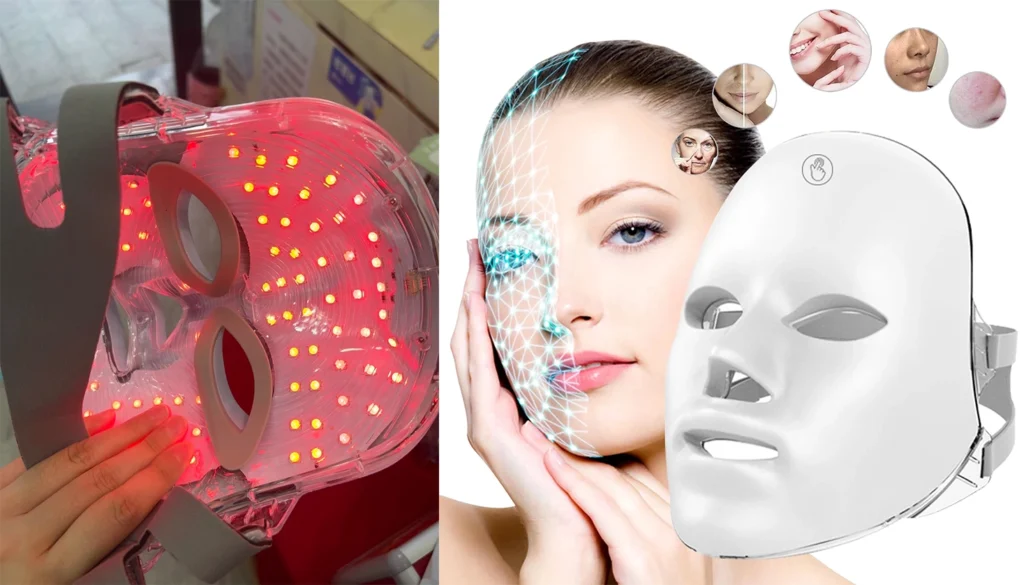
The Glokore LED Face Mask delivers 7 wavelengths in an ergonomic, wireless design that makes daily use effortless. Blue light targets acne bacteria directly while red light calms inflammation and supports skin barrier repair for a dual approach for active breakouts and prevention.
The adjustable treatment times and intensity levels let you customize sessions based on skin sensitivity and breakout severity. Whether managing hormonal flare-ups or maintaining clear skin between breakouts, you can dial settings to match your needs without irritation.
The lightweight, hands-free design means you can wear it while relaxing, reading, or watching content—removing the “treatment feels like a chore” barrier that derails consistency. The wireless functionality eliminates cord tangles and makes it travel-friendly.
Key Features:
- Multiple clinical-grade wavelengths for acne, fine lines, and dark spots
- Quick 10 minute, wireless daily treatments from home
- Adjustable intensity and session length
- Lightweight, comfortable fit with stretchy straps
- FDA-cleared device
Standout feature: Customizable settings allow you to tailor intensity and duration to your specific skin needs and sensitivity levels.
2. Best for Hormonal Acne: CurrentBody Skin LED Light Therapy Mask
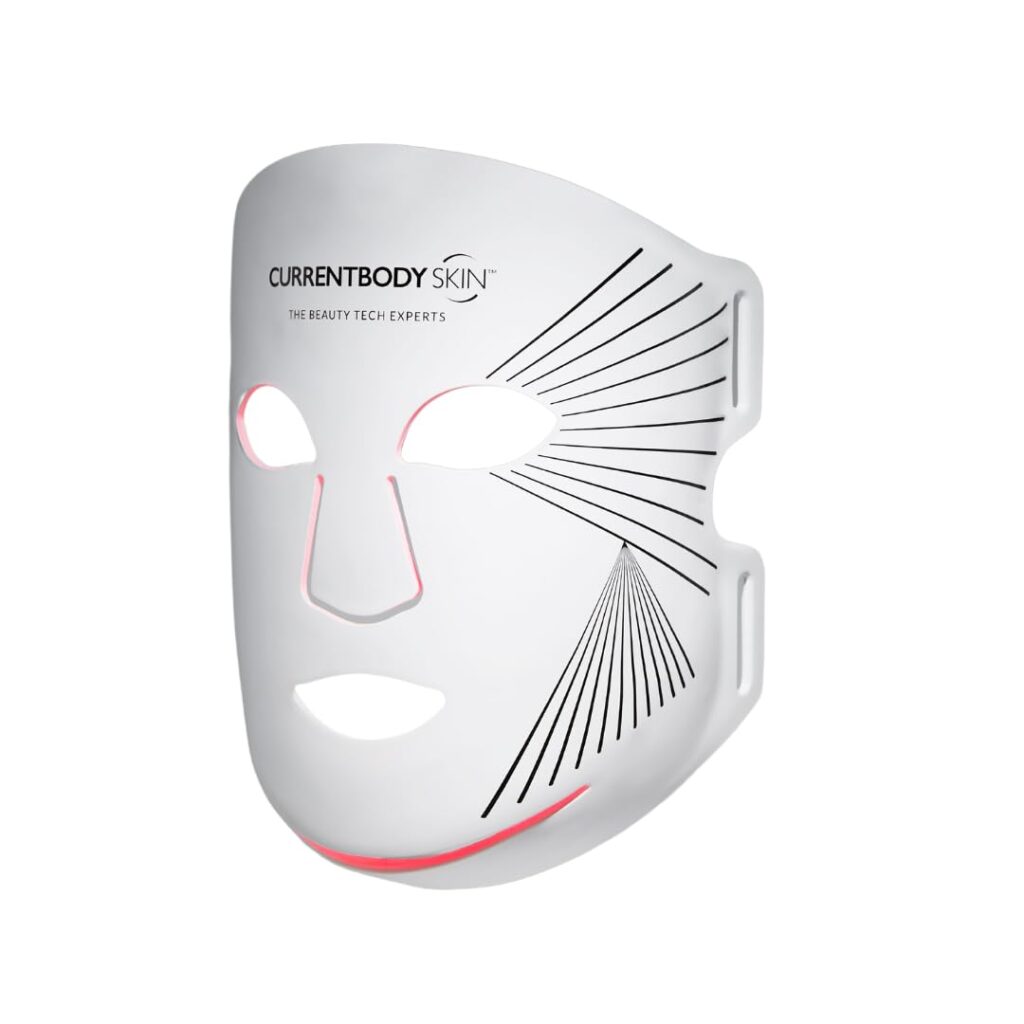
The CurrentBody Skin LED Light Therapy Mask uses flexible, medical-grade silicone that conforms to facial contours—ensuring consistent light delivery to chin, jawline, and cheek areas where hormonal breakouts typically appear. The combination of red (633 nm) and near-infrared (830 nm) light may help reduce the appearance of inflammation and redness often seen with hormonal acne.
While this mask doesn’t include blue light for bacteria targeting, the red and near-infrared wavelengths address the inflammatory component that makes hormonal acne painful and persistent.
The rechargeable, portable design fits easily into travel bags, and the 10-minute session length integrates smoothly into morning or evening routines. The flexible material remains comfortable during the full treatment without pressure points or slipping.
Key specs:
- Red (633nm) and near-infrared (830nm) light
- Flexible silicone design
- Rechargeable and portable
- 10-minute treatment sessions
- Conforms to facial contours
Standout feature: Flexible silicone construction ensures red light reaches difficult areas like the jawline where hormonal breakouts tend to occur.
3. Best for Targeted Treatment: LightStim for Acne
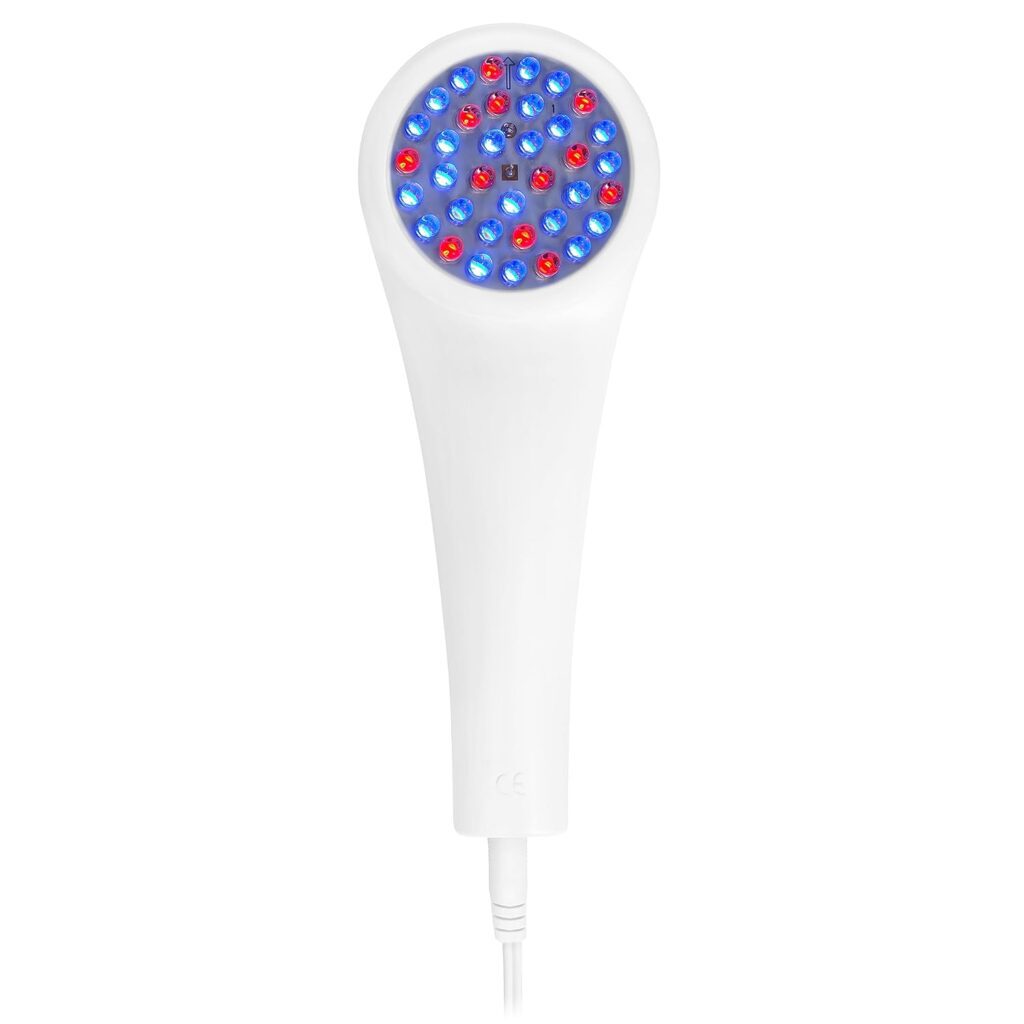
The LightStim for Acne device offers precision control with its handheld design—ideal for spot-treating stubborn breakouts on the chin, nose, or forehead without committing to full-face sessions. The combination of blue and red LEDs addresses both bacteria and inflammation in concentrated problem zones.
The compact size makes it easy to maneuver around nostril creases, hairline, and other areas where full-face masks may not fit securely. This targeted approach works well for people whose acne appears in specific, predictable locations rather than across the entire face.
FDA clearance for mild to moderate acne provides confidence in safety and effectiveness. The device requires no downtime, making it gentle enough for daily spot treatment on sensitive or easily irritated skin.
Key Features:
- Handheld design for precision treatment
- Blue and red LED combination
- FDA-cleared for mild to moderate acne
- Portable and easy to store
Standout feature: Handheld format allows focused treatment on specific breakout zones and hard-to-reach areas.
4. Best Value: Project E Beauty LightAura LED Face Mask
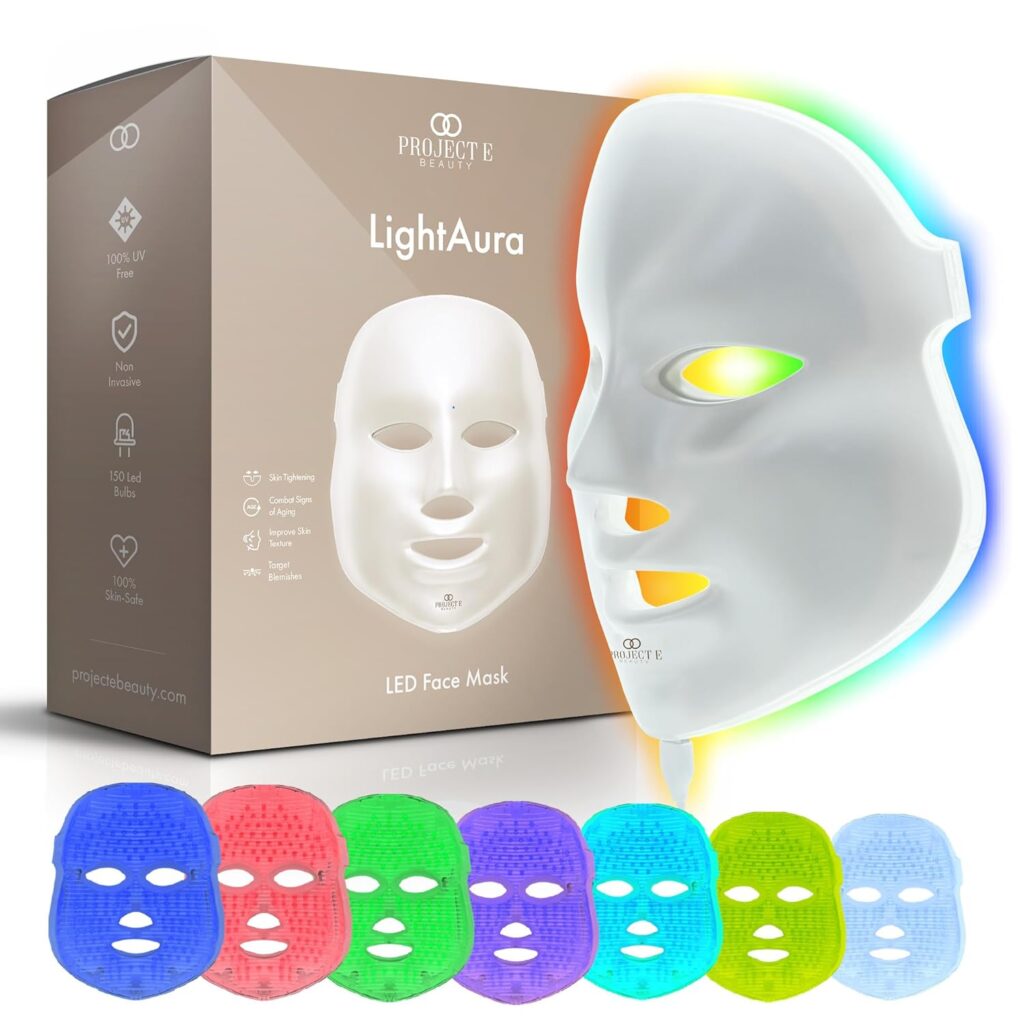
The Project E Beauty LED Face Mask offers seven color wavelengths including blue for acne bacteria and red for inflammation—providing versatility at a fraction of premium device costs. This makes it accessible for those new to LED therapy or managing multiple skin concerns beyond acne.
The wireless, rechargeable design includes adjustable treatment times, so you control session length based on your schedule and skin response. The included protective eye goggles address safety concerns without requiring separate purchases.
While it may not match the irradiance output of clinical-grade devices, the Project E Beauty mask provides a low-barrier entry point to consistent LED therapy. The multiple color options let you experiment with different wavelengths as your skin needs change.
Key Features:
- Seven color options (blue, red, green, yellow, and combinations)
- Wireless and rechargeable
- Adjustable treatment times
- Includes protective eye goggles
- Budget-friendly price point
Standout feature: Multiple wavelength options let you address acne, pigmentation, and other concerns with one device.
5. Best for Sensitive Skin: Shark CryoGlow LED Face Mask
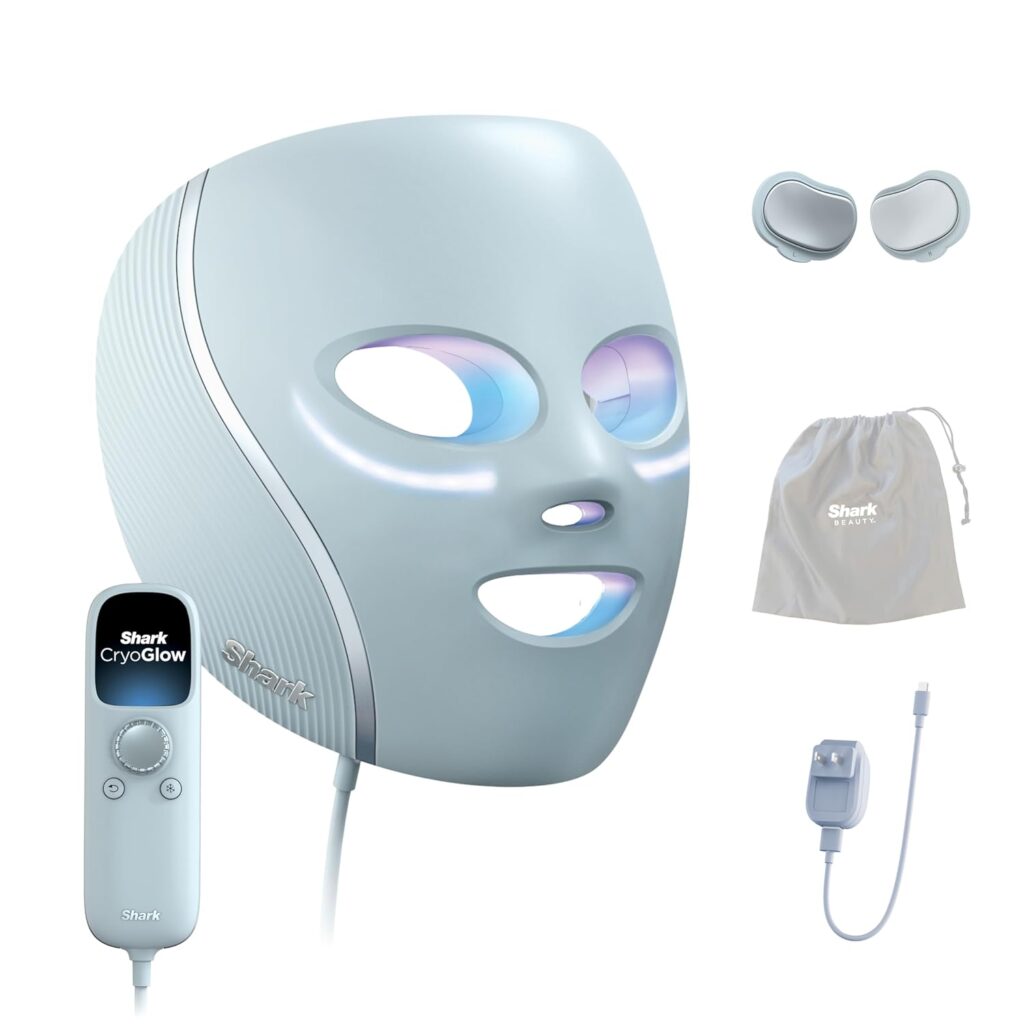
The Shark LED Face Mask delivers blue and red light therapy in a carefully engineered design. The interior sits smoothly against your face without digging in, and the weight feels balanced so you’re not constantly adjusting it during your session.
If you’ve ever felt overwhelmed by skincare devices with twelve different settings and confusing instructions, this one keeps things simple. Pick your session, press start, and it handles the rest. No second-guessing whether you’re using it correctly or picking the wrong mode.
The roomy eye cutouts and airflow design matter more than you’d think—especially if you tend to feel claustrophobic in full-face masks or notice your skin getting hot and flushed during treatments.
Key Features:
- Blue (415nm) and red (630nm) light wavelengths target bacteria and calm inflammation
- Lightweight at under 400g
- Adjustable elastic straps accommodate different head sizes
- 10-minute auto-shutoff prevents overuse and irritation
- Ventilated design prevents heat buildup that can trigger redness
- Simple one-button operation eliminates setup confusion
Standout feature: The comfortable, breathable design makes it workable for reactive skin that usually can’t tolerate intense LED treatments.
LED Mask Fit, Coverage & Comfort for Acne Treatment
When looking for a LED mask to help with acne and inflammation, consider the following:
- Full-face masks provide comprehensive coverage for cheek, forehead, and chin acne, while handheld devices allow targeted treatment on specific zones.
- Lightweight, flexible silicone designs conform better to facial contours than rigid plastic, ensuring light reaches all areas including around the nose and mouth.
- Wireless masks eliminate cord hassle during 10-15 minute sessions, making consistent use easier. For sensitive skin or travel needs, compact options with adjustable straps prevent slipping and pressure marks around the eyes.
Choosing the right format depends on the type of acne you have as well as lifestyle.
Maximizing the Benefits of Your LED Face Mask
To get the most out of your LED face mask, follow these tips:
- Cleanse Your Face: Always start with a clean face to confirm the light can penetrate effectively.
- Be Consistent: Regular use is key to seeing results. Stick to the recommended treatment schedule for your chosen device.
- Protect Your Eyes: Use the provided eye protection or keep your eyes closed during treatments.
- Combine with Other Treatments: LED therapy works well in conjunction with other acne treatments like salicylic acid or benzoyl peroxide. Just be sure to use them at different times of the day to avoid irritation.
- Stay Hydrated: Drinking plenty of water can help enhance the overall health of your skin, potentially boosting the effects of LED therapy.
- Be Patient: Results from LED therapy are not immediate. It may take several weeks of consistent use to see significant improvements.
- Monitor Your Skin: Pay attention to how your skin responds to the treatment and adjust the frequency or intensity if needed.
The Science Behind LED Light Therapy
LED light therapy has gained significant traction in the skincare world, backed by a growing body of scientific research. Here’s a deeper look at how it works:
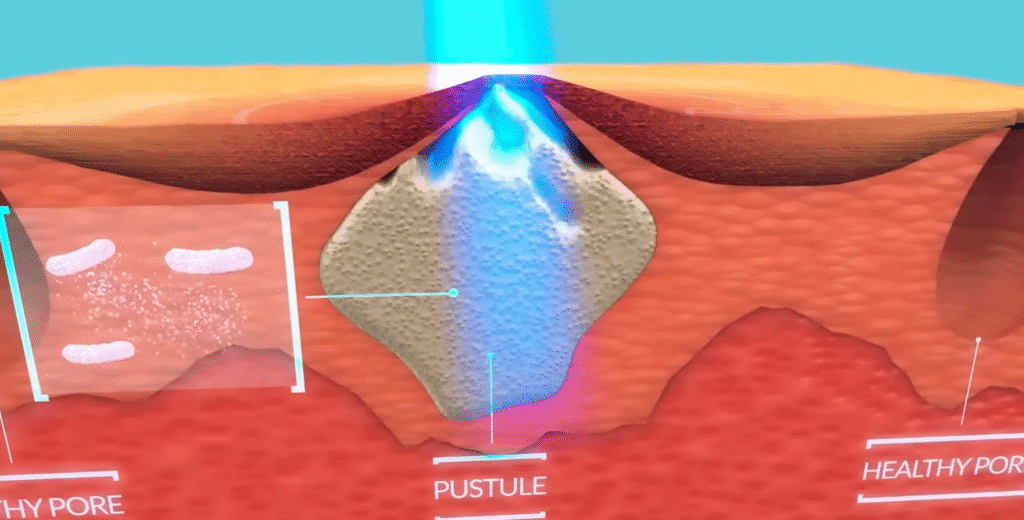
Blue Light Therapy
Blue light, typically in the range of 415-495 nanometers, has been shown to be effective against acne because of its ability to penetrate the skin’s pores and eliminate Propionibacterium acnes (P. Acnes) bacteria.
These bacteria play a crucial role in the development of acne by feeding on sebum and producing inflammatory by-products.
Research on blue light (around 415 nm) shows improvements in mild-to-moderate acne within several weeks in clinic and at-home studies.
Red Light Therapy
Red light, with wavelengths between 620-750 nanometers, penetrates deeper into the skin than blue light. It works by stimulating cellular activity, particularly in fibroblasts, which are responsible for producing collagen and elastin.
Red light is often paired with blue and is discussed in reviews for potential anti-inflammatory effects
Combination Therapy
Many LED masks use a combination of blue and red light, leveraging the benefits of both wavelengths. A randomized study in the British Journal of Dermatology reported about 76% mean improvement in inflammatory lesions after 12 weeks with the combined wavelengths.
Potential Side Effects and Precautions
While LED light therapy is generally considered safe, it’s important to be aware of potential side effects and take necessary precautions:
- Eye Safety: Always use protective eyewear or keep your eyes closed during treatments to avoid potential damage to your retinas.
- Photosensitivity: If you’re taking medications that increase light sensitivity, ask with your doctor before starting LED therapy.
- Skin Irritation: Some people may experience mild redness or irritation after treatment. This usually subsides quickly.
- Overuse: Stick to the recommended treatment times. Overuse won’t necessarily lead to better results and could potentially irritate your skin.
- Pregnancy: While there’s no evidence that LED therapy is harmful during pregnancy, it’s always best to ask with your healthcare provider before starting any new skincare treatment.
- Existing Skin Conditions: If you have any pre-existing skin conditions or are prone to keloid scarring, check with a dermatologist before using an LED mask.
Integrating LED Therapy into Your Skincare Routine
To maximize the benefits of your LED face mask, consider how to best combine it into your existing skincare routine:
- Cleansing: Always start with a clean face. Use a gentle, non-irritating cleanser to remove all makeup, dirt, and oil.
- Exfoliation: If you exfoliate, do so before your LED treatment. This can help the light penetrate more effectively.
- Serums: Apply any water-based serums after your LED treatment. The light therapy can enhance the absorption of these products.
- Moisturizer: Follow up with a moisturizer to lock in hydration and further soothe your skin.
- Sunscreen: If you’re using your LED mask in the morning, always follow up with a broad-spectrum sunscreen.
- Timing: Most experts recommend using LED therapy in the evening, as this is when your skin naturally goes into repair mode.
It’s important to incorporate your LED treatments into your routine at a time that works for you and that you can maintain regularly.
Frequently Asked Questions
What is LED light therapy for acne?
LED light therapy for acne is a non-invasive treatment that uses specific wavelengths of light to target acne-causing bacteria and reduce inflammation. It typically involves blue light to kill bacteria and red light to reduce inflammation and promote healing.
How often should I use an LED face mask for acne?
The frequency of use depends on the specific device and your skin’s needs. Most LED face masks recommend daily use for about 10-20 minutes. Always follow the manufacturer’s instructions for your particular device.
Can LED light therapy worsen acne?
LED light therapy is generally considered safe and is not known to worsen acne. However, some people might experience a temporary increase in breakouts as the skin purges.
If you have concerns, ask with a dermatologist.
How long does it take to see results from LED light therapy for acne?
Results can vary, but many people start to see improvements in their acne after 4-6 weeks of consistent use. More significant results are often seen after 8-12 weeks of regular treatments.
Is LED light therapy safe for all skin types?
LED light therapy is generally safe for all skin types. However, if you have very sensitive skin or any pre-existing skin conditions, it’s best to ask with a dermatologist before starting treatment.
Can I use other acne treatments with LED light therapy?
Yes, LED light therapy can be used in conjunction with other acne treatments. However, it’s important to space out your treatments and be cautious of potential irritation.
Always ask with a skincare professional for personalized advice.
Are at-home LED masks as effective as professional treatments?
While professional LED treatments are typically more powerful, at-home LED masks can still be effective when used consistently. They offer the advantage of convenience and cost-effectiveness for long-term use.
Can LED light therapy help with acne scars?
Red light therapy, in particular, may help improve the appearance of acne scars by stimulating collagen production and promoting skin healing. However, for significant scarring, professional treatments may be more effective.
Is it safe to use LED light therapy during pregnancy?
While there’s no evidence that LED light therapy is harmful during pregnancy, it’s always best to ask with your healthcare provider before starting any new skincare treatment when pregnant.
Can LED light therapy prevent future acne breakouts?
Regular use of LED light therapy can help manage acne and may reduce the frequency and severity of future breakouts. However, it’s most effective when used as part of a comprehensive skincare routine.
Key Takeaways
- LED face masks offer a non-invasive, at-home solution for treating acne and improving overall skin health.
- Blue light targets acne-causing bacteria, while red light reduces inflammation and promotes healing.
- When choosing an LED mask, consider factors like light types, treatment duration, ease of use, and additional features.
- Consistency is key, regular use as directed is crucial for seeing results.
- LED therapy works best as part of a comprehensive skincare routine, including proper cleansing, moisturizing, and sun protection.
- While generally safe, always follow the manufacturer’s instructions and ask with a dermatologist if you have concerns.
- Results typically become noticeable after 4-6 weeks of consistent use, with more significant improvements after 8-12 weeks.
Health Disclaimer: The information in this article is for educational purposes only and is not a substitute for professional medical advice. Consult a dermatologist or healthcare provider before starting LED light therapy, especially if you have pre-existing skin conditions, are pregnant, or are taking photosensitizing medications. Results may vary, and misuse of devices may cause irritation or other side effects.
